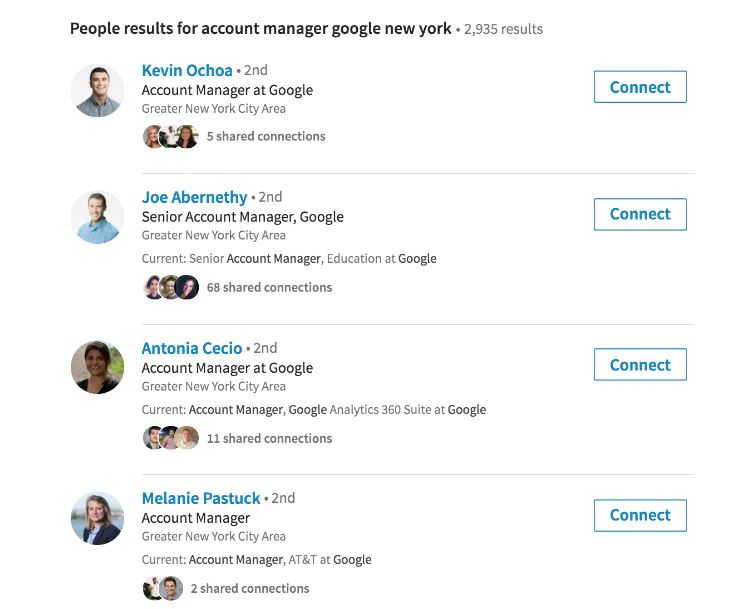3 Steps to Landing Your Dream Job With Cold Email
By Austin Belcak (‘13)
Austin is the founder of Cultivated Culture where he helps people use unconventional strategies to lands jobs they love along with salaries they deserve. Most recently, he’s helped people get hired at places like Google, Microsoft, Amazon, Apple, and Facebook.
Shortly after graduating from Wake, I realized it was time for a career change. I graduated with a biology degree and a job in the medical field, but my dream was to work in tech for a company like Google or Microsoft. I began my job search the way most of us do – tweaking my resume, applying online, and crossing my fingers.
Three months and several hundred applications later, I hadn’t heard back from a single company. Every time I hit “Submit” it felt like my resume was being sucked into a black hole, never to be heard from again. It was incredibly frustrating. Statistics in Carswell helped me realize that my sample size was large enough to predict what would happen if I continued down this path. I had to change tactics.
When we’re looking for a new career opportunity, one of our first moves is to check if our family, friends, or network has any leads. If they do, they can refer us in right?
I certainly didn’t have any contacts at places like Google or Microsoft, but I figured that if I could get in touch with a few people there, I could turn those connections into job offers. So I began reaching out via cold email. That strategy helped me land interviews and offers at Google, Microsoft, and Twitter without connections, without “traditional” experience, and without applying online. In this post, I’ll walk you through the process you can use to build connections and land a job referral, even if you don’t know anyone at the company.
Step 1: Find The Best Person To Contact
Before reaching out, it helps to have an idea of the role, industry, and/or company you want to work for. The more specific, the better. We’re aiming to target people who can influence the hiring process right down to the decision to make an offer. LinkedIn is your best friend when it comes to finding the right people. All you need to do is fire up the platform and search for each of the criteria mentioned above (role, company, geography, etc.)
For example, I wanted to work as an account manager for Google in New York, so my search looked like this: Account Manager Google New York
That will bring up a bunch of people who fit our specific criteria – all awesome leads for us to contact:
Pro Tip: Always add Wake Forest to the “School” filter on your first search. If someone pops up, you have an immediate connection that will increase your chances of getting a response and a referral.
We’re going to want to add each of these people to a spreadsheet like this one to help you keep track of your outreach. Once we have a decent list of names, our next step is to find the contact information for each person on the list. My favorite tool for this is Voila Norbert. You simply enter the person’s name + their company’s website and Norbert will find their corporate email in just a few seconds. Here’s Jeff Bezos for example:
Go ahead and add each email to your spreadsheet.
Step 2: Crafting Your Outreach
Now you have a list of highly relevant contacts with a deep knowledge of the role you want, as well as the ability to influence the hiring decision for that job. Our next step is to reach out and begin building relationships with these people.
If you’ve never sent a cold email, it can be a little intimidating. Trust me, I get it – I was in the exact same position. I can tell you from personal experience that the hardest part is pressing “Send” the first few times. If you’re up for that, I promise it will be worth it.
Over the past few years, I have sent thousands of cold emails to different contacts at different levels. Here are a few data-driven tactics you can implement to help improve your response rates. They’re the same ones I used to get in touch with people like Arianna Huffington:
Your Subject Line
My go-to subject line for cold outreach is almost always “Quick Question.” The exception would be having a referral from a friend or a strong point of commonality like graduating from Wake Forest, in which case I’d include that. “Quick Question” originated from a Fast Company experiment where they emailed 1,000+ F500 and Inc 500 executives. “Quick Question” saw the highest response rate at 65% and I saw similar results when I used it.
The Anatomy of a Good Cold Email
Now we need to craft our content in a way that gets to the point quickly and encourages a response. Here are a few guidelines that research has shown to help boost response rates:
- Keep things short (120 words is the sweet spot with a 51% response rate)
- Ask a question – emails with one question in them typically see more replies
- Be slightly positive but don’t overdo it. Including a few exclamation points and positive language can boost response rates 15%
- Note that their time is valuable and give them an “out”
A final piece of advice is to position the person as an expert and ask them for help. Everyone wants to be recognized for the work they do and humans are wired to help one another. Combining those two elements with the guidelines above is the recipe for a great email.
To give you an example that combines everything above, here’s the template I used with a lot of success. In this case, I played into my contact’s history of landing a job in tech with a non-traditional background:
Hi Tim,
My name is Austin, I hope you don’t mind me reaching out of the blue. I found your profile on LinkedIn while looking for people with non-traditional backgrounds who landed jobs in tech. Your journey really stood out to me.
I’d love to learn a little bit more about how you transitioned out of Accounting as well as your experience at Google so far. Would you be up to chat through a few questions?
I know that your time is extremely valuable so please don’t feel the need to respond in depth. If you do have a few minutes to chat, I would really appreciate it.
If not, no worries at all – wishing you an awesome 2018!
Best,
Austin
If you don’t hear back, feel free to follow up after 5 business days.
Step 3: Find Ways To Add Value & Build The Relationship
When the time comes to hop on the phone with your contact, you have one goal in mind – get as much information as you possibly can around:
- Challenges they/their team is facing
- Upcoming initiatives they are driving
- Personal goals
The trick is to work those questions into the natural flow of the conversation. Lead off with questions about their experience and their journey. For example:
- What prompted them to make a career change?
- How did they decide on their current company?
- What’s an unexpected lesson they learned while making the transition?
- If someone wanted to start from scratch, with no experience, what steps should they take to replicate your results?
Once the conversation is warmed up, dive into their challenges and initiatives. The answers to these questions will give you a roadmap for adding value that directly applies to the role they’re hiring for.
Your next steps are to research the obstacles/initiatives your contact laid out and build out a project that showcases the value you can add to the team. This could be a slide deck that recaps the issues and lays out clear solutions, it could be a one-sheet of solutions based on customer feedback you sourced, or it could be leads you generated for the company’s sales team — the possibilities are endless and it definitely requires some creativity.
For a more detailed look on how to successfully build out a value-add project, check out this article as well as these real world examples of creative methods people used to land their dream jobs.
Once your project is complete, send it back to your contact and asking for their feedback:
Hey Tim,
Thank you again for taking the time to chat with me last week.
I thought a lot about our conversation, especially the piece around [challenge]. I actually went ahead and put some solutions together, I’ve attached them here.
If you have a few minutes to check them out, I’d love to get your feedback.
Best,
Austin
If your project is on point, your contact will typically share it out with the greater team and the feedback should lead them to follow up with:
“Those solutions you provided were fantastic. You know, we have an open role on our team. Is that something you might be interested in?”




